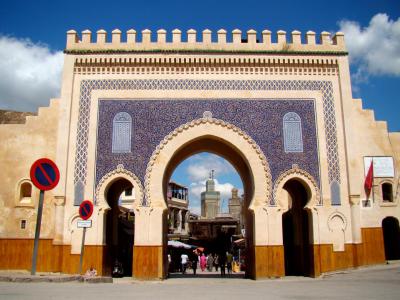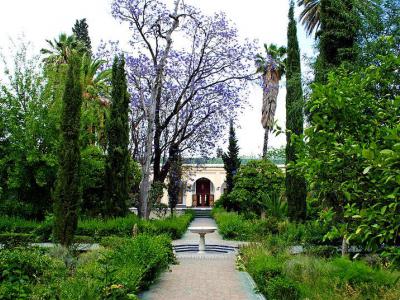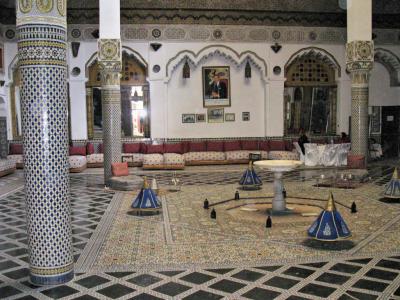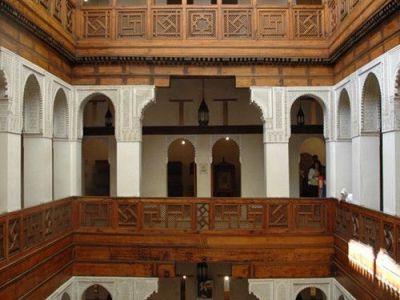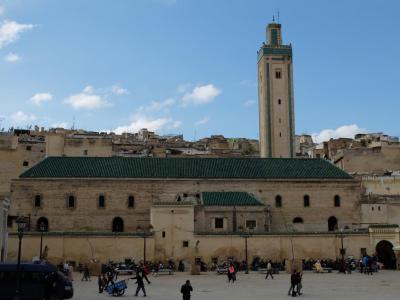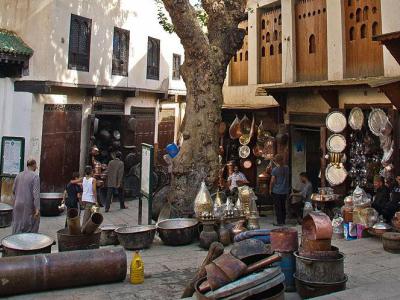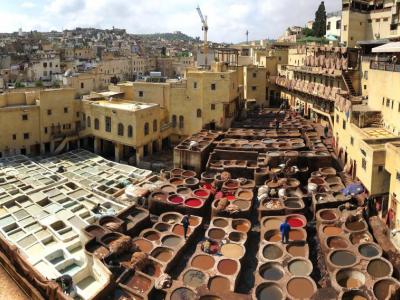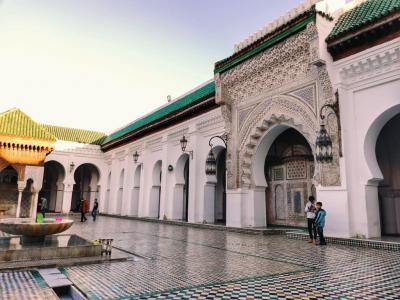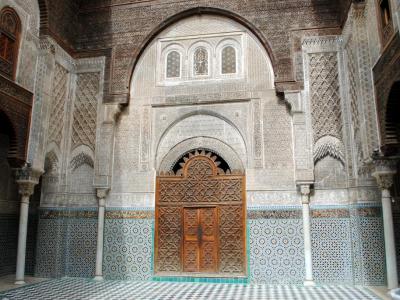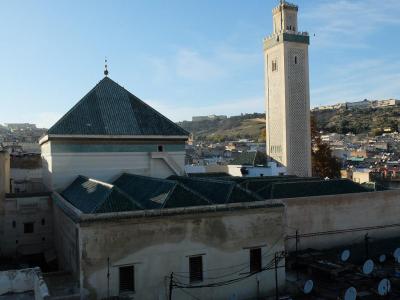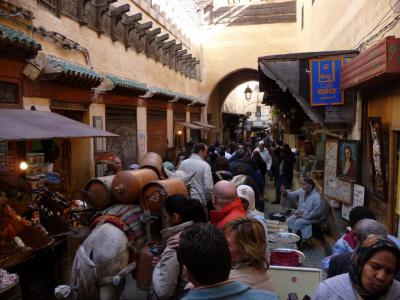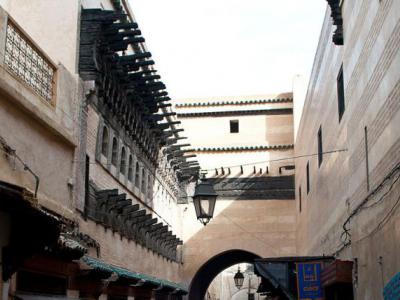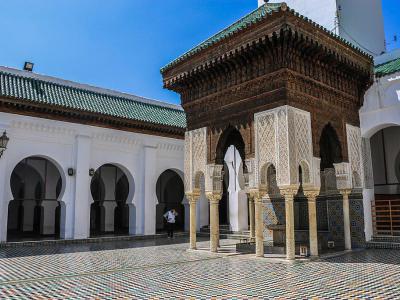Fes Old Town Walking Tour (Self Guided), Fes
North and west of the fabled Atlas Mountains of North Africa is the ancient city of Fes, or Fez. It is centered on the Fes River.
In the year 789 Idris I founded the city and the Idrisid dynasty. The city was two settlements on either side of the river. In the 11th century, Sultan Yusuf ibn Tashfin established Almoravid rule. He united the settlements into Fes el-Bali. The Almoravids were followed by the Wattasids, Saadis, and the Marinids in 1250.
Fes had a golden age in the 13th-15th centuries. During this time many of the surviving mosques and madrasas were built. Fes Jdid was established in 1276 by Sultan Abu Yusuf Yaqub as a royal district. The Marinids were overthrown in 1465. The Alaouite dynasty ruled until 1912.
The city is the two old town quarters Fes el-Bali and Fes Jdid and the modern town Ville Nouvelle. The Ville was founded in the French colonial era. It is a cosmopolitan district, home to affluent citizens and european ex-pats.
Beyond the Blue Gate (Bab Bou Jeloud), there is much to see. The Bou Jeloud mosque dates from the 12th century, the Mosque of the Andalusians was founded in 859. The great Mosque of Fez el-Jdid was built in the Marinid era in 1276. In addition to the many ornate, imposing mosques are the madrasas, schools, hammams and synagogues.
The oldest university in the world, madrasa al Qarawiyyin, is still awarding degrees. There are tanneries, palaces, souks. And in the center of it all is the Jnane Sbil Gardens, the Lalla Mina Gardens of the Royal Palace and the gardens of the Dar al-Beida.
Ever recreating itself and yet retaining the serenity of Islamic traditions, Fes awaits the traveler who looks beyond a golf course or a bar. It has many secrets and mysteries to be unraveled.
In the year 789 Idris I founded the city and the Idrisid dynasty. The city was two settlements on either side of the river. In the 11th century, Sultan Yusuf ibn Tashfin established Almoravid rule. He united the settlements into Fes el-Bali. The Almoravids were followed by the Wattasids, Saadis, and the Marinids in 1250.
Fes had a golden age in the 13th-15th centuries. During this time many of the surviving mosques and madrasas were built. Fes Jdid was established in 1276 by Sultan Abu Yusuf Yaqub as a royal district. The Marinids were overthrown in 1465. The Alaouite dynasty ruled until 1912.
The city is the two old town quarters Fes el-Bali and Fes Jdid and the modern town Ville Nouvelle. The Ville was founded in the French colonial era. It is a cosmopolitan district, home to affluent citizens and european ex-pats.
Beyond the Blue Gate (Bab Bou Jeloud), there is much to see. The Bou Jeloud mosque dates from the 12th century, the Mosque of the Andalusians was founded in 859. The great Mosque of Fez el-Jdid was built in the Marinid era in 1276. In addition to the many ornate, imposing mosques are the madrasas, schools, hammams and synagogues.
The oldest university in the world, madrasa al Qarawiyyin, is still awarding degrees. There are tanneries, palaces, souks. And in the center of it all is the Jnane Sbil Gardens, the Lalla Mina Gardens of the Royal Palace and the gardens of the Dar al-Beida.
Ever recreating itself and yet retaining the serenity of Islamic traditions, Fes awaits the traveler who looks beyond a golf course or a bar. It has many secrets and mysteries to be unraveled.
How it works: Download the app "GPSmyCity: Walks in 1K+ Cities" from Apple App Store or Google Play Store to your mobile phone or tablet. The app turns your mobile device into a personal tour guide and its built-in GPS navigation functions guide you from one tour stop to next. The app works offline, so no data plan is needed when traveling abroad.
Fes Old Town Walking Tour Map
Guide Name: Fes Old Town Walking Tour
Guide Location: Morocco » Fes (See other walking tours in Fes)
Guide Type: Self-guided Walking Tour (Sightseeing)
# of Attractions: 15
Tour Duration: 2 Hour(s)
Travel Distance: 3.7 Km or 2.3 Miles
Author: leticia
Sight(s) Featured in This Guide:
Guide Location: Morocco » Fes (See other walking tours in Fes)
Guide Type: Self-guided Walking Tour (Sightseeing)
# of Attractions: 15
Tour Duration: 2 Hour(s)
Travel Distance: 3.7 Km or 2.3 Miles
Author: leticia
Sight(s) Featured in This Guide:
- Bab Boujeloud (Blue Gate)
- Dar Batha Museum
- Dar Mnebhi (Mnebhi Palace)
- Fondouk el-Nejjarine / Nejjarine Museum of Wooden Arts and Crafts
- Cherratine Madrasa (School of the Rope Makers)
- R'cif Square and R'cif Mosque
- Place Seffarine (Seffarine Square)
- Chouara Tannery
- Kairaouine Mosque and University
- Al-Attarine Madrasa (School of the Perfumers)
- Al-Attarine Souk (Spice Market)
- Zawiya de Moulay Idriss II (Shrine of Moulay Idriss II)
- Talaa Kebira (Great Slope Street)
- Dar al-Magana (Water Clock)
- Bou Inania Madrasa (Bou Inania Seminary)
1) Bab Boujeloud (Blue Gate) (must see)
Enclosed within imposing walls, the large Pacha el-Baghdadi Square serves as a link between the medina and Fès el-Jedid. On one side of it stands Bab Boujeloud, a meeting place with a great concentration of cafés and stalls. With its distinctive polychrome-tiled facades in blue (the traditional color of Fes) on the outside and green (symbolizing Islam) facing the Medina, it's a pretty unmistakable sight.
Constructed in 1913 in the Moorish style, this fine monumental structure consists of three symmetrical horseshoe arches. Despite being a millennium younger than the surrounding medina, dating back to the French protectorate era, it is considered the primary and most aesthetically pleasing entry point into Fès el-Bali. Interestingly, the gate locks from the outside, which may have been a measure implemented by French authorities to keep the unruly old city bottled up at night.
As the use of heavy artillery evolved, the fortified gates of Fès transitioned from practical defense mechanisms to ornamental structures, enhancing the city's prestige and facilitating the collection of city taxes. From this entranceway, visitors can catch a glimpse of the minaret of the Bou Inania Medersa to the left, and enjoy the car-free surroundings.
Constructed in 1913 in the Moorish style, this fine monumental structure consists of three symmetrical horseshoe arches. Despite being a millennium younger than the surrounding medina, dating back to the French protectorate era, it is considered the primary and most aesthetically pleasing entry point into Fès el-Bali. Interestingly, the gate locks from the outside, which may have been a measure implemented by French authorities to keep the unruly old city bottled up at night.
As the use of heavy artillery evolved, the fortified gates of Fès transitioned from practical defense mechanisms to ornamental structures, enhancing the city's prestige and facilitating the collection of city taxes. From this entranceway, visitors can catch a glimpse of the minaret of the Bou Inania Medersa to the left, and enjoy the car-free surroundings.
2) Dar Batha Museum
Before immersing yourself in the streets of the medina, take some time to explore the Batha Museum housed within the Dar Batha Palace, just south of the Blue Gate. Construction of this edifice was initiated by Moulay el-Hassan in 1873, with the intention of creating a residence suitable for hosting official receptions. Apart from the traditional Moorish architecture that has survived to this day, notable features include the grand courtyard covered with colorful tiles and centered around a large fountain. A spacious and very fine Andalusian garden was laid out as well, offering visitors a serene oasis to pause and rejuvenate.
In 1914, the esteemed French scholar Alfred Bel, an expert in Near and Far Eastern cultures, made the first donation toward establishing the future ethnographic museum. The following year, Dar Batha Palace – a work of art in its own right – officially became the Museum of Moroccan Arts and Crafts, showcasing a diverse collection divided into two main sections. While the first section highlights archaeological artifacts, the second focuses on ethnography, showcasing the rich arts and crafts of Fès and its surrounding regions. Visitors can admire ceramics, paintings, textiles, jewelry, wooden doors, genealogical records, and everyday objects.
Of particular interest is an exhibition tracing the evolution of architecture in Fès from the Idrissid period to the Alaouite era. Additionally, one has the opportunity to observe woodcarvers at work in an on-site workshop.
Tip:
While exploring the exhibits, be sure to gaze upward and admire the intricately designed ceilings.
In 1914, the esteemed French scholar Alfred Bel, an expert in Near and Far Eastern cultures, made the first donation toward establishing the future ethnographic museum. The following year, Dar Batha Palace – a work of art in its own right – officially became the Museum of Moroccan Arts and Crafts, showcasing a diverse collection divided into two main sections. While the first section highlights archaeological artifacts, the second focuses on ethnography, showcasing the rich arts and crafts of Fès and its surrounding regions. Visitors can admire ceramics, paintings, textiles, jewelry, wooden doors, genealogical records, and everyday objects.
Of particular interest is an exhibition tracing the evolution of architecture in Fès from the Idrissid period to the Alaouite era. Additionally, one has the opportunity to observe woodcarvers at work in an on-site workshop.
Tip:
While exploring the exhibits, be sure to gaze upward and admire the intricately designed ceilings.
3) Dar Mnebhi (Mnebhi Palace)
This early 20th-century palace, situated in the heart of the old medina of Fes, holds historical significance as the site where the 1912 Treaty of Fes was ratified, marking the establishment of French colonial rule over Morocco. Positioned on Tala'a Seghira street, one of the main souq streets of the city, it was commissioned by Mehdi Mnebhi, the defense minister of Sultan Abdelaziz, between 1900 and 1908. Mnebhi also oversaw the construction of another palace, now housing the Marrakech Museum.
Following its completion, the palace served as the initial residence of the French resident-general, Lyautey, and later became the headquarters of the Istiqlal (Independence) party in Morocco. Today, it has been repurposed as a restaurant venue where visitors can indulge in mint tea while enjoying panoramic views from the rooftop.
The palace's architectural grandeur is evident upon entering the vast reception hall, with its lofty wooden dome ceiling supported by four majestic columns, alongside a striking wall fountain adorned with intricate ‘zellij’ mosaic tiles. Flanking the reception hall are two additional rooms with equally elaborate decorations.
Following its completion, the palace served as the initial residence of the French resident-general, Lyautey, and later became the headquarters of the Istiqlal (Independence) party in Morocco. Today, it has been repurposed as a restaurant venue where visitors can indulge in mint tea while enjoying panoramic views from the rooftop.
The palace's architectural grandeur is evident upon entering the vast reception hall, with its lofty wooden dome ceiling supported by four majestic columns, alongside a striking wall fountain adorned with intricate ‘zellij’ mosaic tiles. Flanking the reception hall are two additional rooms with equally elaborate decorations.
4) Fondouk el-Nejjarine / Nejjarine Museum of Wooden Arts and Crafts (must see)
Dominating the corner of Nejjarine Square is the wonderful Fondouk of the same name, dating back to the late 17th century and exuding the rich aroma of cedar and thuya wood. Originally serving as a roadside inn catering to caravans and traders in luxury goods, the structure was thoroughly restored and now functions as a museum dedicated to woodworking techniques and tools. Skilled craftsmen can be observed crouching over intricately carved furniture and decorative items, including tables, bed frames, and chairs.
Visitors are further captivated by the display of 14th- to 18th-century cedar-wood friezes on the first floor, as well as much more modern creations like a rabab (string instrument) beautifully inlaid with mother-of-pearl on the floor above. However, it is the impeccably restored interior of the building itself that truly captivates, making the entrance fee worthwhile. Recognized as a historic monument in 1916 and now a UNESCO World Heritage Site, the fondouk also offers amazing views of the Medina from its rooftop café.
Additionally, the nearby Nejjarine Fountain commands attention as a magnificent display of ‘zellige’ decoration, serving as a focal point in the square. Next to it, a large covered workshop is dedicated to the creation of elaborately decorated palanquins and thrones, often used in ceremonial events such as circumcisions or weddings.
Visitors are further captivated by the display of 14th- to 18th-century cedar-wood friezes on the first floor, as well as much more modern creations like a rabab (string instrument) beautifully inlaid with mother-of-pearl on the floor above. However, it is the impeccably restored interior of the building itself that truly captivates, making the entrance fee worthwhile. Recognized as a historic monument in 1916 and now a UNESCO World Heritage Site, the fondouk also offers amazing views of the Medina from its rooftop café.
Additionally, the nearby Nejjarine Fountain commands attention as a magnificent display of ‘zellige’ decoration, serving as a focal point in the square. Next to it, a large covered workshop is dedicated to the creation of elaborately decorated palanquins and thrones, often used in ceremonial events such as circumcisions or weddings.
5) Cherratine Madrasa (School of the Rope Makers)
A walk up Rue Cherratine leads to the restored Cherratine school, offering a unique perspective compared to other schools in the city. Constructed in 1670 during the reign of Moulay Rachid, the founder of the Alaouite dynasty, this institution reflects a departure from the ornate and decorative style of earlier Merinid madrasas to a more utilitarian and functional design.
While sharing structural similarities with the 14th-century Merinid madrasas, the Cherratine school is characterized by its austere architecture, primarily intended to accommodate over 200 students. The entrance doors, intricately engraved in bronze, open into the "douiras" – narrow residential blocks comprised of small rooms meant for said students.
Classified as a historic heritage monument in Morocco since 1917, the school once stood nearby a market where rope-makers were established, hence its name. In addition to the central courtyard, visitors have the opportunity to explore nearly all the rooms.
While sharing structural similarities with the 14th-century Merinid madrasas, the Cherratine school is characterized by its austere architecture, primarily intended to accommodate over 200 students. The entrance doors, intricately engraved in bronze, open into the "douiras" – narrow residential blocks comprised of small rooms meant for said students.
Classified as a historic heritage monument in Morocco since 1917, the school once stood nearby a market where rope-makers were established, hence its name. In addition to the central courtyard, visitors have the opportunity to explore nearly all the rooms.
6) R'cif Square and R'cif Mosque
Though the cafés around the Blue Gate ("Bab Boujeloud") are always ripe with entertainment of the people-watching variety, head down to the R'cif Square to take in a truly authentic local experience, especially around sunset. Children play, women gather, and visitors can soak in the lively ambiance from the stadium-style seating.
The square's focal point is the so-called "Mosque of the Paved Road", a significant edifice with its towering minaret and imposing presence on the city's skyline. Built in the 18th century on the cliffside by the Bou Khrareb River, it serves as a landmark at the entrance to the nearby pier and the city's central markets (or "souqs").
Inside the mosque, you will find a spacious courtyard bordered by arcaded galleries, typical of Moroccan mosque architecture. At the center of the courtyard is a rectangular water basin, providing a place for ablutions, sheltered by a small pavilion. Meanwhile, the prayer hall, marked by rows of horseshoe arches, invites worshippers to engage in prayer and contemplation.
The square's focal point is the so-called "Mosque of the Paved Road", a significant edifice with its towering minaret and imposing presence on the city's skyline. Built in the 18th century on the cliffside by the Bou Khrareb River, it serves as a landmark at the entrance to the nearby pier and the city's central markets (or "souqs").
Inside the mosque, you will find a spacious courtyard bordered by arcaded galleries, typical of Moroccan mosque architecture. At the center of the courtyard is a rectangular water basin, providing a place for ablutions, sheltered by a small pavilion. Meanwhile, the prayer hall, marked by rows of horseshoe arches, invites worshippers to engage in prayer and contemplation.
7) Place Seffarine (Seffarine Square)
Standing adjacent to the Kairaouine Mosque and dating back to the Middle Ages, Place Seffarine is almost willfully picturesque. Here, one can witness the age-old craft of metalworking as 'dinandiers' skillfully hammer away at immense copper cauldrons, creating a captivating scene against the backdrop of a gnarled old tree. A welcome respite after navigating the streets of the central Medina, the square invites travelers to pause for a refreshing drink and orient themselves before continuing their exploration along various routes.
Gazing toward the Kairaouine Mosque at the square's apex, visitors will catch sight of the University Library, once home to the most extensive collection of Islamic, mathematical, and scholarly books outside of Baghdad. While much of the library's treasures were lost or dispersed during the city's decline in the 17th century, it still preserves some remarkably rare texts and manuscripts, including a 9th-century Koran written on deerskin with gold leaf in an ancient Kufic script.
Also nearby is the Seffarine Madrasa, dating back to around 1270 and recognized as the oldest purpose-built madrasa in Morocco. Distinguished by its architectural resemblance to a traditional Fassi house, this structure features an arched balcony overlooking its courtyard and retains traces of its former grandeur in the lofty prayer hall.
Gazing toward the Kairaouine Mosque at the square's apex, visitors will catch sight of the University Library, once home to the most extensive collection of Islamic, mathematical, and scholarly books outside of Baghdad. While much of the library's treasures were lost or dispersed during the city's decline in the 17th century, it still preserves some remarkably rare texts and manuscripts, including a 9th-century Koran written on deerskin with gold leaf in an ancient Kufic script.
Also nearby is the Seffarine Madrasa, dating back to around 1270 and recognized as the oldest purpose-built madrasa in Morocco. Distinguished by its architectural resemblance to a traditional Fassi house, this structure features an arched balcony overlooking its courtyard and retains traces of its former grandeur in the lofty prayer hall.
8) Chouara Tannery (must see)
The largest tannery in Fes and arguably the most striking sight in the Medina, Chouara exudes a compulsive fascination for visitors. Each morning, the site buzzes with activity as cascades of water flow through openings that were once windows of nearby houses. Hundreds of skins are spread out on the rooftops to dry, while amidst the vats of dye and pigeon dung, an almost surreal scene unfolds as tanners treat the hides. The sight is like something out of a Gothic fantasy, with the rotation of colors in the honeycombed vats following a traditional sequence-yellow (from turmeric), red (from poppy), blue (from indigo), green (from mint), and black (from antimony).
Despite the occasional modern addition like rinsing machines, little seems to have changed here since the 16th century when Fes supplanted Cordoba as the premier city of leather production. The ownership structure remains intricately feudal, with foremen overseeing hereditary guilds and workers passing down their specific jobs from one generation to the next.
While there is a sensuous beauty to the tannery's operations, there's also a certain element of guilt in indulging in the spectacle, especially as one observes the gallery of camera-touting foreigners capturing the scene.
Tip:
To view the tannery up close, visitors typically ascend into the leather shops overlooking the site, often paying a small fee to the guardians (who may provide a sprig of mint to help combat the strong odor).
Despite the occasional modern addition like rinsing machines, little seems to have changed here since the 16th century when Fes supplanted Cordoba as the premier city of leather production. The ownership structure remains intricately feudal, with foremen overseeing hereditary guilds and workers passing down their specific jobs from one generation to the next.
While there is a sensuous beauty to the tannery's operations, there's also a certain element of guilt in indulging in the spectacle, especially as one observes the gallery of camera-touting foreigners capturing the scene.
Tip:
To view the tannery up close, visitors typically ascend into the leather shops overlooking the site, often paying a small fee to the guardians (who may provide a sprig of mint to help combat the strong odor).
9) Kairaouine Mosque and University (must see)
The Kairaouine complex (pronounced "kare-a-ween") is a sight to behold, yet for non-Muslims, it often remains shrouded in mystery. One of the main entrances is at the end of the Talâa Kbira, offering a glimpse of the vast courtyard inside, although it may not fully convey the immense size of this complex. Muslims are welcomed inside for prayer and to explore the university grounds, though classes may be in session at times. It's common for worshippers to guide Muslim visitors around, showcasing the marvels of this truly remarkable structure.
Founded in 857 by Fatima al-Fihri, daughter of a wealthy refugee from Tunisia, the mosque has undergone several expansions and renovations over the centuries. The most significant expansion occurred in the 12th century under the Almoravids, who enlarged the prayer halls and footprint of the mosque to accommodate up to 22,000 worshippers.
Adjacent to the mosque, the Kairaouine University, sometimes touted as the oldest university globally, was initially established as a "medersa" alongside the mosque. While it wasn't officially recognized as a university until it joined Morocco's state educational system in 1963, UNESCO acknowledges it as the oldest continuously operating educational institution in the world, far ahead of those in Europe.
Venturing into the heart of the old Medina to catch a glimpse of this legendary institution is well worth it, following which you can pause for a quick bowl of bissara to recharge. While non-Muslims may have restricted access, they can still appreciate the traditional courtyard with its washing area (reserved for men) and the prayer area. The mixture of indoor and outdoor spaces make the complex truly amazing.
Founded in 857 by Fatima al-Fihri, daughter of a wealthy refugee from Tunisia, the mosque has undergone several expansions and renovations over the centuries. The most significant expansion occurred in the 12th century under the Almoravids, who enlarged the prayer halls and footprint of the mosque to accommodate up to 22,000 worshippers.
Adjacent to the mosque, the Kairaouine University, sometimes touted as the oldest university globally, was initially established as a "medersa" alongside the mosque. While it wasn't officially recognized as a university until it joined Morocco's state educational system in 1963, UNESCO acknowledges it as the oldest continuously operating educational institution in the world, far ahead of those in Europe.
Venturing into the heart of the old Medina to catch a glimpse of this legendary institution is well worth it, following which you can pause for a quick bowl of bissara to recharge. While non-Muslims may have restricted access, they can still appreciate the traditional courtyard with its washing area (reserved for men) and the prayer area. The mixture of indoor and outdoor spaces make the complex truly amazing.
10) Al-Attarine Madrasa (School of the Perfumers) (must see)
Al-Attarine stands out among the city's medieval colleges for its remarkable abundance and diversity of patterning. Still, despite the striking richness of its ‘zellij’, woodwork, and stucco, the decoration maintains an air of grace, ensuring the building's elegant proportions are never overwhelmed. Completed in 1325, the madrasa is one of the earliest in Fes. Its overall lightness is achieved through the clever use of pairs of symmetrical arches to connect the marble pillars to a single weight-bearing lintel.
On your way in, take a moment to admire the entrance hall, which boasts perhaps the most intricate ‘zellij’ decoration in the city. Its circular design, featuring an interlace of pentagons and five-pointed stars, exemplifies the intricate craftsmanship and philosophical depth employed by the artisans. Scholars have noted that the patterns radiate from a single point, symbolizing the belief in the oneness of God, manifested as the center of every form or being.
The first floor houses cells for over sixty students, which served as an annex to the Kairaouine University until the 1950s. If you're fortunate enough to gain access (which can be sporadic), the rooftop offers one of the most complete views of the Kairaouine Mosque imaginable.
On your way in, take a moment to admire the entrance hall, which boasts perhaps the most intricate ‘zellij’ decoration in the city. Its circular design, featuring an interlace of pentagons and five-pointed stars, exemplifies the intricate craftsmanship and philosophical depth employed by the artisans. Scholars have noted that the patterns radiate from a single point, symbolizing the belief in the oneness of God, manifested as the center of every form or being.
The first floor houses cells for over sixty students, which served as an annex to the Kairaouine University until the 1950s. If you're fortunate enough to gain access (which can be sporadic), the rooftop offers one of the most complete views of the Kairaouine Mosque imaginable.
11) Al-Attarine Souk (Spice Market)
As you stroll down Tarafine Street (Talâa Kebira), your nose is greeted by the sweet smell of cinnamon, cumin, and cloves, floating through the air like a fragrant welcome mat to the Al-Attarine Souk, also known as the "Spice Market". Once the pinnacle of sophisticated shopping, this market now offers an eclectic array of goods, from lamps to teapots, mirrors to sunglasses, and even those kitschy souvenirs you can't resist buying. Follow one narrow side street and you'll find yourself surrounded by a rainbow of "babouches", those colorful slippers that beckon you to slip into comfort.
Dating back to the days of the early Idrisid rulers (think 9th-10th centuries), this bazaar has seen its fair share of drama, from fires to floods to the inevitable modern touch-ups involving lots of concrete. But fear not, the recent renovations in 2016 and 2017 brought back the charm with new wooden roofs, spiffy tile decorations, and several practical upgrades.
And don't forget the golden rule of Moroccan market economics: where there's a grand mosque, there's fancy stuff for sale nearby. Just take a peek around the Kairaouine, and you'll see the spice sellers giving way to silk traders and shops peddling those intricately embroidered takchitas, perfect for any fancy occasion-even if it's just lounging at home binge-watching your favorite shows.
Dating back to the days of the early Idrisid rulers (think 9th-10th centuries), this bazaar has seen its fair share of drama, from fires to floods to the inevitable modern touch-ups involving lots of concrete. But fear not, the recent renovations in 2016 and 2017 brought back the charm with new wooden roofs, spiffy tile decorations, and several practical upgrades.
And don't forget the golden rule of Moroccan market economics: where there's a grand mosque, there's fancy stuff for sale nearby. Just take a peek around the Kairaouine, and you'll see the spice sellers giving way to silk traders and shops peddling those intricately embroidered takchitas, perfect for any fancy occasion-even if it's just lounging at home binge-watching your favorite shows.
12) Zawiya de Moulay Idriss II (Shrine of Moulay Idriss II)
Just south of the busy Al-Attarine Souk lies the Shrine of Moulay Idriss, a holy hotspot that's been casting its spiritual shadow over Fes for five centuries. Rebuilt in the 18th century by Sultan Moulay Ismail, it stands as his one and only act of piety in the city-quite the grand gesture, wouldn't you say?
Now, if you stroll down Derb Bab Moulay Ismail, which starts from the southeast corner of Nejjarine Square, you'll spot a wooden bar. That's where the shrine's sanctuary zone kicks off. Back in the day, before the French came and took over in 1911, that bar was the cut-off point for Christians, Jews – and, yes, mules as well. If you were Muslim and dared to step past it, you basically had the right to claim asylum from prosecution or apprehension. But times change, and nowadays non-Muslims can at least gawk at the outside of the ‘zaouia’. Peek through discreetly, and you might just catch a glimpse of the saint's final resting place.
Slide under that wooden bar like you're in a spy movie and make your way up Derb Bab Moulay Ismail. Prepare for sensory overload as stalls hawking everything from silverware to nougat assault your senses. Keep your eyes peeled for the women's entrance-it's your window into the inner sanctum. Looking in from the doorway, the 15th-century shrine of Moulay Idriss is quite discernible within the distant chamber, amid an ambiance redolent of fervent devotion.
A noteworthy peculiarity, characteristic of several ‘zaouias’ yet seldom observable externally, are the myriad European clocks, bestowed as prestigious gifts and held in high esteem during the 19th century, having been imported from Manchester by prominent Fassi merchant clans. Who knew keeping time could be so cosmopolitan?
Now, if you stroll down Derb Bab Moulay Ismail, which starts from the southeast corner of Nejjarine Square, you'll spot a wooden bar. That's where the shrine's sanctuary zone kicks off. Back in the day, before the French came and took over in 1911, that bar was the cut-off point for Christians, Jews – and, yes, mules as well. If you were Muslim and dared to step past it, you basically had the right to claim asylum from prosecution or apprehension. But times change, and nowadays non-Muslims can at least gawk at the outside of the ‘zaouia’. Peek through discreetly, and you might just catch a glimpse of the saint's final resting place.
Slide under that wooden bar like you're in a spy movie and make your way up Derb Bab Moulay Ismail. Prepare for sensory overload as stalls hawking everything from silverware to nougat assault your senses. Keep your eyes peeled for the women's entrance-it's your window into the inner sanctum. Looking in from the doorway, the 15th-century shrine of Moulay Idriss is quite discernible within the distant chamber, amid an ambiance redolent of fervent devotion.
A noteworthy peculiarity, characteristic of several ‘zaouias’ yet seldom observable externally, are the myriad European clocks, bestowed as prestigious gifts and held in high esteem during the 19th century, having been imported from Manchester by prominent Fassi merchant clans. Who knew keeping time could be so cosmopolitan?
13) Talaa Kebira (Great Slope Street)
Cutting through Fès el-Bali and stretching all the way down to the Kairaouine Mosque, under various names, Talâa Kebira (Big Slope) stands out as the main thoroughfare of the Medina. It's not so much about specific landmarks as it is about the sensory overload you'll experience along the way: signs with camel heads pointing to the local butchers, vendors haggling in the spice and slipper markets, and donkeys hauling their loads up and down the bumpy lanes.
At the western end of the street, you'll find mostly produce markets, butchers, and other food shops. As you move past the Bou Inania Madrasa, the shops become more diverse, catering to both rural visitors and locals. A bit further down, you'll come across a group of fondouks – just a handful of the 200 or so that used to populate Fès el-Bali. Originally built around the same time as the madrasa, these were lodging houses for traders and their trusty mules: big two-story buildings with rooms surrounding spacious central courtyards.
Some notable examples include Bousl Hame at No. 49 Talaa Kebira (on the left), now home to an interesting drum workshop, and about 50 meters ahead, Qaât Smen (marked on the right), where you'll find a small market for butter and honey (you'll know you're close by the strong smell of smen – a fancy aged butter used in the best couscous). Just a bit further down (also on the right) is the rundown Fondouk Tazi, with a few pottery stalls and workshops, and a few meters away (on the left) is the mostly abandoned and quite smelly Fondouk Lbbata, piled high with sheepskins being prepared for curing and tanning.
At the western end of the street, you'll find mostly produce markets, butchers, and other food shops. As you move past the Bou Inania Madrasa, the shops become more diverse, catering to both rural visitors and locals. A bit further down, you'll come across a group of fondouks – just a handful of the 200 or so that used to populate Fès el-Bali. Originally built around the same time as the madrasa, these were lodging houses for traders and their trusty mules: big two-story buildings with rooms surrounding spacious central courtyards.
Some notable examples include Bousl Hame at No. 49 Talaa Kebira (on the left), now home to an interesting drum workshop, and about 50 meters ahead, Qaât Smen (marked on the right), where you'll find a small market for butter and honey (you'll know you're close by the strong smell of smen – a fancy aged butter used in the best couscous). Just a bit further down (also on the right) is the rundown Fondouk Tazi, with a few pottery stalls and workshops, and a few meters away (on the left) is the mostly abandoned and quite smelly Fondouk Lbbata, piled high with sheepskins being prepared for curing and tanning.
14) Dar al-Magana (Water Clock)
Across Talâa Kebira Street, nearly opposite the entrance of the Bou Inania Madrasa, you will spot an extraordinary water clock ("magana") crafted by the late-13th century Abou 'I-Hassan Ali, who was especially important in the fields of trigonometry and practical astronomy. Although the clock was removed for research purposes, the woodwork has since been restored, while the metal components await replacement, as part of a comprehensive renovation project aimed at revitalizing many of the Medina's long-neglected sites.
A captivating enigma, this water-run hydraulic clock features a row of thirteen windows and platforms, seven of which still hold their original brass bowls. Despite considerable efforts, its exact functioning remains elusive. However, according to a contemporary account, every hour, one of its windows would open, releasing a weight that dropped into the corresponding bowl below.
A captivating enigma, this water-run hydraulic clock features a row of thirteen windows and platforms, seven of which still hold their original brass bowls. Despite considerable efforts, its exact functioning remains elusive. However, according to a contemporary account, every hour, one of its windows would open, releasing a weight that dropped into the corresponding bowl below.
15) Bou Inania Madrasa (Bou Inania Seminary) (must see)
The Bou Inania madrasa, constructed in the 1350s by the Merinid sultan Bou Inan, stands out as one of the most architecturally refined theological colleges in Fes. The building is divided into two sections, with a long corridor running between them. The eastern side houses the madrasa proper, while the western side contains an annex for ablutions, although it is no longer in use. At the main entrance, a flat-sided dome crowns the structure, adorned with horseshoe arches featuring intricately delicate stucco decorations.
Upon entering, a corridor leads to a stunning courtyard, centered around a pool. Three sides of the courtyard are lined with a gallery, while the fourth side opens onto the prayer hall. The green-tiled awnings, exquisitely carved wood, elaborate stucco work, ‘zellij’ tilework, and mosaic-like tiled floor make the courtyard a captivating sight. The prayer hall itself remains unchanged, while students' cells occupy the rest of the ground floor and upper floor. From the terrace, visitors can enjoy an excellent panoramic view of the medina.
Unique to the Bou Inania madrasa is its adjoining mosque, which is closed to visitors during prayer times. The mihrab niche, visible from across the prayer hall, features onyx columns reminiscent of the Great Mosque of Córdoba. The mosque's beautiful green-tiled minaret is visible when entering the medina via Bab Bou Jeloud.
Upon entering, a corridor leads to a stunning courtyard, centered around a pool. Three sides of the courtyard are lined with a gallery, while the fourth side opens onto the prayer hall. The green-tiled awnings, exquisitely carved wood, elaborate stucco work, ‘zellij’ tilework, and mosaic-like tiled floor make the courtyard a captivating sight. The prayer hall itself remains unchanged, while students' cells occupy the rest of the ground floor and upper floor. From the terrace, visitors can enjoy an excellent panoramic view of the medina.
Unique to the Bou Inania madrasa is its adjoining mosque, which is closed to visitors during prayer times. The mihrab niche, visible from across the prayer hall, features onyx columns reminiscent of the Great Mosque of Córdoba. The mosque's beautiful green-tiled minaret is visible when entering the medina via Bab Bou Jeloud.
Walking Tours in Fes, Morocco
Create Your Own Walk in Fes
Creating your own self-guided walk in Fes is easy and fun. Choose the city attractions that you want to see and a walk route map will be created just for you. You can even set your hotel as the start point of the walk.
Fes New Town Walking Tour
Created by the French in the early 20th century, Ville Nouvelle (New Town) is a relatively modern central district of Fez. A far cry from the sensory overload provided by the old Medina, this neighborhood was originally designed to accommodate foreigners and affluent Moroccans only.
Still, Fez's Ville Nouvelle is as much 'real' Morocco as any donkey-packed lane in the old city.... view more
Tour Duration: 1 Hour(s)
Travel Distance: 2.7 Km or 1.7 Miles
Still, Fez's Ville Nouvelle is as much 'real' Morocco as any donkey-packed lane in the old city.... view more
Tour Duration: 1 Hour(s)
Travel Distance: 2.7 Km or 1.7 Miles
The Most Popular Cities
/ view all



